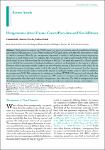Metagenomics-driven Virome: Current Procedures and New Additions
Kohl, Claudia
Nitsche, Andreas
Kurth, Andreas
Next generation sequencing (NGS) opened up a plethora of new research possibilities in biology and medicine. Metagenomics is one of these emerging NGS applications and offers the opportunity to study i.e. whole ecosystems. Basically, the metagenomics approach is similar to well-known shotgun-sequencing, though on a much bigger scale. For instance, the metagenome of a lake would include all the fish, ducks, plants, fungi, bacteria and everything else that belongs to the lake. If we apply this approach to clinical samples we can identify the community of etiological pathogens, without any knowledge on the targets in advance. However, clinical specimens usually comprise an overwhelming amount of host nucleic acids, which by far exceeds the number of pathogen nucleic acids in the sample. Subsequently, it is necessary to either decrease the amount of host nucleic acids or increase the amount of pathogen nucleic acids, to allow for detection via metagenomic NGS. This minireview is revising our developed TUViD-VM protocol and selected other approaches regarding their suitability in metagenomics. We provide an overview on the difficulties, challenges and opportunities that developed alongside metagenomic virus discovery. The field of metagenomics from clinical specimens promises the identification of novel, yet unknown, infectious diseases and etiologies.
Dateien zu dieser Publikation
Keine Lizenzangabe

